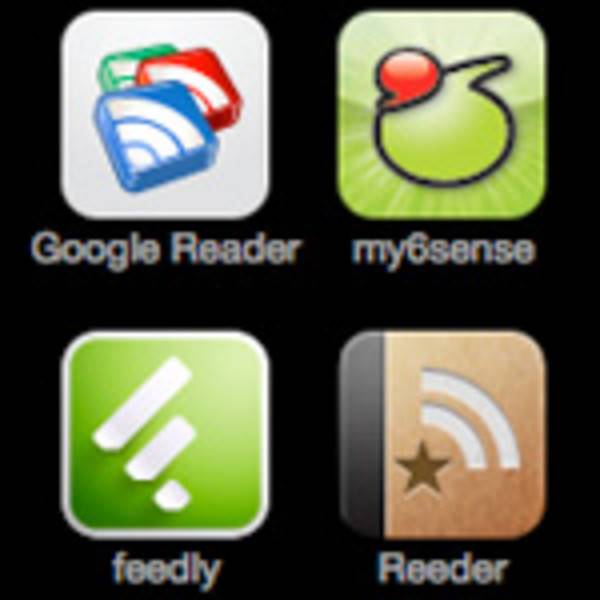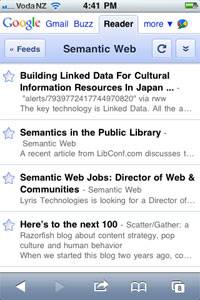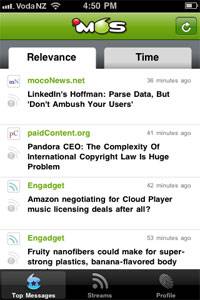RSS feeds were a big driver of innovation in the Web 2.0 era. RSS Readers like Bloglines, Newsgator and Google Reader became the go-to services for people to subscribe to the latest news and blog posts. Over the past couple of years, mobile phones have become a major content consumption device. Yet RSS Readers have struggled to make the transition. In part this has been due to the increased importance of Twitter and Facebook for circulating news and information. But it’s also because tracking RSS feeds on your smartphone is a user interface challenge – and few, if any, startups have solved it.

This is the third post in our series looking at how the user experience (UX) of consuming media has changed with the increasing popularity of devices other than the PC. The first post explored the thriving world of music on smartphones and yesterday we looked at news apps on the iPad. Today we analyze RSS on smartphones.
Most Popular Mobile RSS Readers Amongst RWW Readers
To get a sense of what is currently popular, I polled followers of our @RWW Twitter account – along with followers of my own personal Twitter account @ricmacnz – about their favorite mobile RSS Reader.
5 services stood out as being the most popular among our readers. They were, in alphabetical order:
- Feedly (iPhone / Android)
- Google Reader (optimized for mobile in the browser)
- my6sense (iPhone / Android)
- Pulse (iPhone / Android)
- Reeder (iPhone)
mobileRSS (iPhone) and Byline (iPhone) were also mentioned multiple times.
User Experience of Mobile RSS Readers
Of the top 5 services according to RWW readers, the mobile version of Google Reader is the most conventional. It lists out your folders and feeds, then you click on them to scan and view stories. It works fairly well, although the main issue is that it’s not as easy to scan stories as it is on a PC. That’s not the fault of Google Reader. Rather it’s the much smaller screen space on a smartphone, which means you end up spending a lot of time swiping and scrolling.

That in a nutshell is why RSS Readers have struggled to get take-up on smartphones. It’s just too much work on a mobile phone to use an RSS Reader as it is intended, to scan hundreds or even thousands of feeds.
The other 4 services in our top 5 list have taken more innovative approaches to solve this problem. Although it should be noted that 3 of them use Google Reader as a platform for the actual feeds (Pulse is the only one not to).
My6sense filters your feeds and attempts to automatically select the most “relevant” stories to you. It also offers a time-based list of feeds and stories, but its main reason for being is to convert you to the relevance filter. So far this new type of feed reading hasn’t taken off in a big way. It reminds me of Google’s “I’m Feeling Lucky” option, in that you have to trust that the software will deliver you the results you want. I wonder whether modern Web users have the patience to build up that trust in my6sense.

Another app taking an innovative approach to mobile RSS Readers is Feedly, a personal favorite of ReadWriteWeb’s resident RSS expert Marshall Kirkpatrick. Marshall reviewed Feedly in January, noting its “attractive folder-based navigation that’s easy to thumb through horizontally.” Similar to my6sense, Feedly filters your feeds. In Feedly’s case, it uses a popularity metric to pick out key items. For example, in my ‘Internet of Things’ folder from Google Reader, Feedly selected two pages worth of items to show me (9 items, to be exact).
Work in Progress
In conclusion, it’s fair to say that RSS reading on smartphones is not yet a solved problem. There is no efficient way to scan through hundreds of feeds on a mobile phone, so apps like my6sense and Feedly have chosen to take a filtering approach.
It’s partly a software issue. Filtering is a mix of art and science; it’s hard to get it right. But also it’s a shift in user experience. RSS Readers never really became mainstream on computers and those who do use them – power users or people who need to track information for their job – haven’t yet become comfortable with RSS Readers filtering their feeds. Web users have become accustomed to letting people filter information via Twitter or Facebook, so perhaps it’s just a matter of time before they let software do filtering too.
Let us know in the comments if you use an RSS Reader on your smartphone; and if so what your experience has been like.









